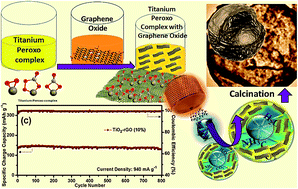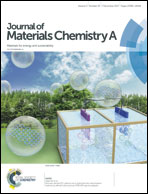TiO2-rGO nanocomposite hollow spheres: large scale synthesis and application as an efficient anode material for lithium-ion batteries†
Abstract
We report here a controllable large-scale synthesis protocol for TiO2-rGO nanocomposites with a hollow spherical morphology by a novel aerosol-assisted spray drying method followed by calcination. The developed strategy is easy to scale-up without significant change in morphology. The precursors used for the synthesis are aqueous titanium ammonium peroxo-carbonate complex (TAPCC) solution, being decomposable at low temperatures, and an aqueous graphene oxide (GO) suspension; no additive or structure-directing agent is required. Both the precursors play vital roles in hollow sphere formation. The enhanced internal pressure inside the atomized droplets built-up in situ through decomposition of TAPCC forming gaseous CO2, NH3, O2 and H2O vapour, helps overcome the crumpling effect of GO. The sheet structure of GO provides sufficient mechanical strength to prevent bursting of the expanded droplets. The synthesized TiO2-rGO hollow spheres are porous, composed of 10–20 nm TiO2 particles dispersed on the surfaces of rGO with a surface area of 86 m2 g−1. The synthesized TiO2-rGO composites showed superior electrochemical performance as lithium-ion battery (LIB) anode with capacity values of 265 mA h g−1 (10 wt% rGO) and 274 mA h g−1 (20 wt% rGO) at 18.8 mA g−1 as compared to 236 mA h g−1 for the pristine sample with a 2D flake-like morphology. This is due to the unique thin-walled hollow-spherical structure of TiO2-rGO composites, which provides a large number of electrochemically accessible active sites, favorable diffusion paths for Li+ ions and enhanced charge transport. Thus, the present synthetic method has great potential for large scale production of TiO2-rGO hollow spheres for application as anode in practical high-rate lithium-ion batteries.



 Please wait while we load your content...
Please wait while we load your content...